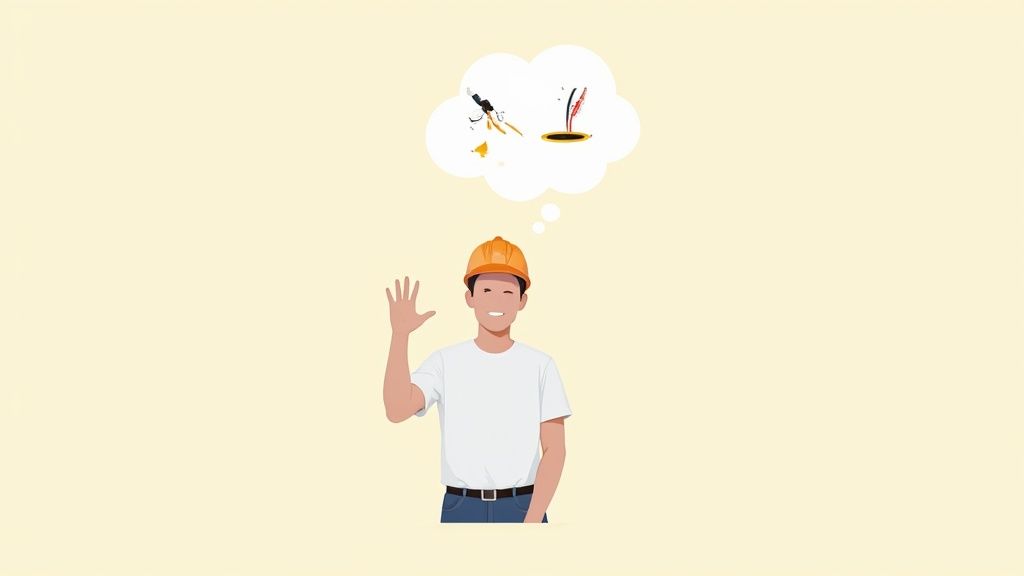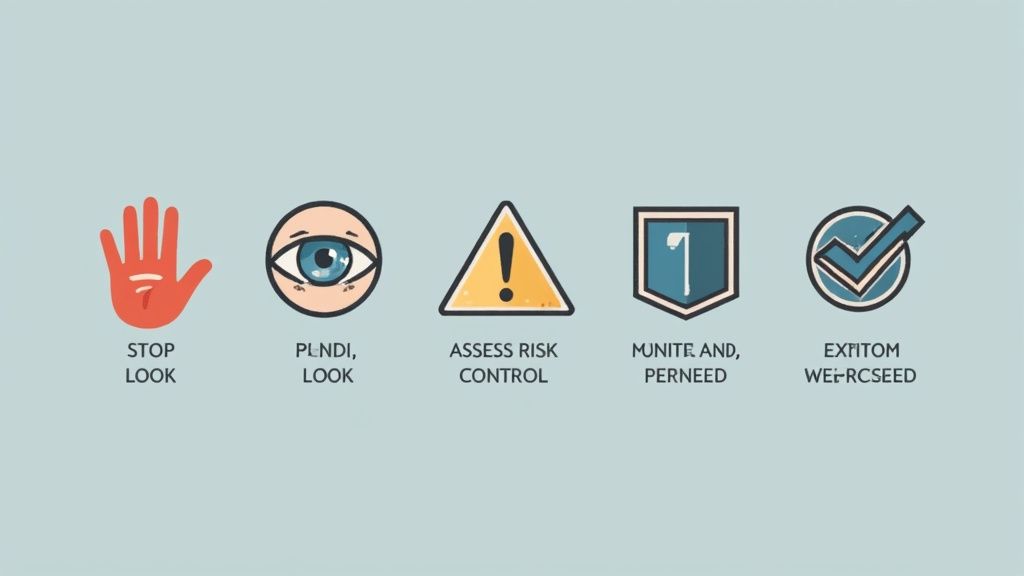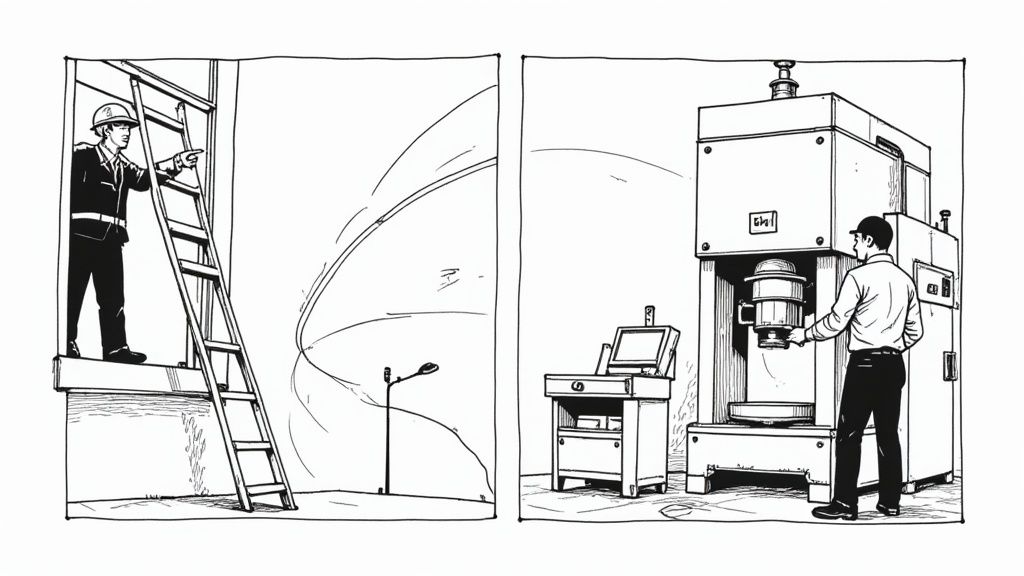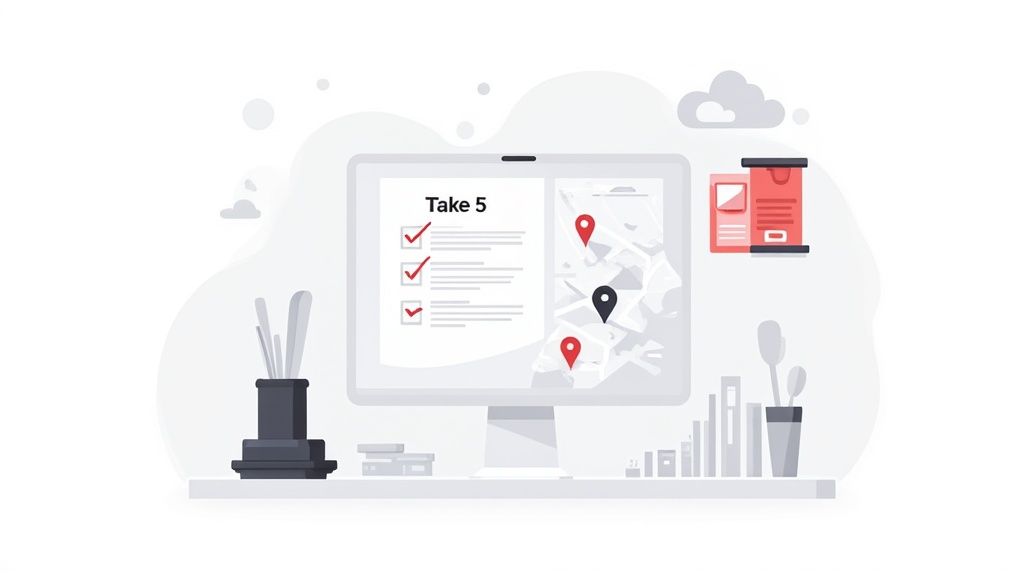The Take 5 for Safety is a simple, effective tool that’s all about pausing before you start a task. It's a quick, on-the-spot hazard check you do right before you get to work. Think of it as a final mental walkthrough to catch any immediate risks that might have been missed in a more formal plan.
Understanding the Take 5 Process
At its heart, the Take 5 for Safety is a straightforward method made to stop incidents before they happen. This isn’t about filling out long forms; it’s about taking a practical pause to check your immediate surroundings and the job at hand. This is especially important in changing environments like a busy construction site or a manufacturing floor, where conditions can change in a moment.

The real goal here is to spot and manage hazards that a broader risk assessment might have overlooked. For example, a welder might use a Take 5 and notice a small, previously unseen puddle of oil near their work area, a clear fire risk. This simple check is what turns a routine job into a safe one.
Why This Matters on Your Worksite
Stopping for just a few minutes before you start a job can make all the difference. The value of this quick check becomes obvious when you look at the stats. In a single year, Australia recorded 188 worker fatalities due to traumatic workplace injuries. The leading causes were vehicle incidents (42%) and falls from height (13%), which really shows the real-world dangers present on many worksites.
By taking five minutes, you are actively looking for the unexpected. A delivery truck might have left a pallet in a walkway, or a fluid leak could have created a slip hazard. These are exactly the kinds of issues a Take 5 is designed to catch.
This process is most effective when it becomes second nature, especially:
- Before starting any new or unfamiliar task.
- When job conditions change, like the weather turning or new equipment arriving on site.
- After returning to a task following a break.
Ultimately, it’s a personal risk assessment that helps workers identify immediate dangers. Of course, a key part of this is knowing what to look for. Understanding the impact of solid safety measures is important, particularly when you see how new technology like drones for rescue and lifesaving efforts is changing emergency response.
Breaking Down the Take 5 Safety Process
The Take 5 for safety process is less about filling out forms and more about building a quick, reflexive mental habit. It’s not meant to be a long, drawn-out exercise. Instead, it’s a simple, logical thought process that comes down to five distinct, practical actions.
When your team learns these steps, they start to consistently spot and manage hazards before anyone gets hurt. It becomes second nature.

This method provides a reliable framework for that quick pre-task risk assessment. Each part builds on the last, guiding a worker from a general awareness of their surroundings to taking specific actions that make the job safer for everyone.
Let's walk through what this looks like on the ground.
The table below gives a simple breakdown of the process, but the real benefit comes when your crew starts applying it instinctively to every task, no matter how small.
The Take 5 for Safety Process Explained
| Action | What to Do | Real-World Example (Construction) |
|---|---|---|
| Stop & Think | Pause before starting. Mentally walk through the job. What are the steps? What tools are needed? What should the area look like? | Before starting a grinder, a worker stops to consider the task: cutting a steel beam. They confirm they have their face shield, gloves, and fire extinguisher nearby. |
| Look & Identify | Actively scan the work area. Look for anything out of the ordinary: broken equipment, spills, poor lighting, missing guards, etc. | The same worker glances around and spots a trailing electrical lead from another tool lying across their path, a clear trip hazard. |
| Assess the Risk | For each hazard, think: what could go wrong, and how bad could it be? Is it a minor slip or a potential fatality? | They assess the risk: tripping while holding an active angle grinder could cause a severe cut or worse. It’s a high-consequence risk. |
| Control the Hazard | Take action to remove or reduce the risk. This could be cleaning up, adding a barrier, or getting different PPE. If you can't, report it. | The worker takes 30 seconds to re-route the lead overhead, completely removing the trip hazard from their immediate work zone. |
| Monitor & Proceed | Start the task, but stay aware. Conditions change. If a new hazard appears, repeat the process. | They begin cutting the beam. Halfway through, a forklift enters the area. They stop, reassess the new hazard, and wait for it to clear before safely continuing. |
As you can see, it's a practical loop, not a one-off checklist. A few seconds of conscious thought can make all the difference between a near-miss and a serious incident.
From Autopilot to Engaged
The initial pause, just stopping before you start, is easily the most important part of the Take 5. It shifts a worker from just going through the motions to being actively engaged and mindful of the situation. This is your team's chance to mentally rehearse the job before touching a single tool.
Spotting Trouble Before It Starts
Identifying hazards is about a deliberate scan, not just a quick glance. A machine operator might notice a frayed cord or that a critical safety guard has been left off. On a construction site, this could be anything from an unsecured ladder and a new excavation to trip hazards like scattered tools and materials. You’re training your team to spot problems before they can cause harm.
Connecting Hazards to Harm
Once a hazard is spotted, the next step is to connect it to a potential outcome. Seeing a small puddle of oil on a workshop floor is one thing. Recognizing it could cause someone carrying a heavy load to slip and suffer a serious back injury, that's assessing the risk.
The most effective controls are often the simplest ones. It might be wiping up a spill, putting up a temporary barrier, or grabbing the right pair of gloves. If a worker can't control the hazard themselves, they must know to stop and report it immediately.
Safety Isn't "Set and Forget"
The final step is important because work environments are rarely static. As the job progresses, new people might enter the area, weather can change, or equipment can fail. The Take 5 isn’t just for the start of the task; it’s a continuous loop.
If a new hazard appears, the process starts again. This cycle of awareness makes sure risks are managed throughout the entire job, creating a much safer and more controlled work environment.
Take 5 for Safety Examples in Construction and Manufacturing
Theory is one thing, but seeing the Take 5 for safety process in action is where its value really clicks. Let's step onto a construction site and a factory floor to see how this quick check can prevent a serious injury.
These examples aren't just textbook scenarios; they show how the five simple steps translate directly into smarter, safer decisions on the ground. You'll see exactly how taking a moment to pause can completely change the outcome of a routine task.

Construction Scenario: Installing a Second-Storey Window
Picture this: a glazier is on a new residential build, about to install a heavy window on the second storey. It's a job she's done a hundred times.
But before touching the window, she stops and thinks. The plan is to use a large extension ladder to move the window into place. She mentally runs through the weight of the frame, the gusty wind, and the fact that this is a two-person job, minimum.
Next, she looks and identifies the hazards. The ground where the ladder needs to go is soft and uneven from recent rain, not a stable base. The wind is picking up, which could turn the large glass pane into a sail. To make matters worse, she spots a pile of offcuts left by another trade right where the ladder needs to be, a classic trip hazard.
She then assesses the risk of each hazard. An unstable ladder on soft ground, combined with a heavy, awkward load, creates a high risk of a fall. A strong gust could easily make her or her partner lose their grip, sending the window crashing down. The potential for serious injury is obvious.
To control the hazards, she makes a call: the ladder is the wrong tool for the job today. She gets on the radio to her supervisor, and they agree to bring in a mobile scaffold instead. The scaffold offers a much larger, more stable working platform. They also decide to wait for a brief lull in the wind and clear away the offcuts before setting up.
Finally, they can proceed and monitor. Working from the stable platform, they safely install the window, all while keeping a close eye on the weather. A simple pause avoided a potential disaster.
Manufacturing Scenario: Operating a Press Machine
Now, let's head into a busy factory. A machine operator is starting his shift at a metal press. Take 5 principles are a perfect fit for fast-paced manufacturing and industrial environments.
First, he stops and thinks about the task ahead: running a batch of stamped parts. He reminds himself that this machine has two-hand controls for a reason and that all guards must be securely in place before he even thinks about starting.
He then looks and identifies any changes in his work area. His eyes immediately catch a small puddle of hydraulic fluid on the floor near the machine's base, a clear slip hazard. He does a quick check of the primary safety guard to make sure it's locked in and confirms the emergency stop button is unobstructed.
Next, he assesses the risk. Slipping on that oil while the machine is running could be catastrophic. An improperly fitted guard could lead to a severe crush injury. It's the small, overlooked details that often cause the biggest problems.
For a task performed hundreds of times a day, it's the small, overlooked changes in the environment that often lead to the biggest problems. A quick check prevents complacency.
He controls the hazards before starting any work. He grabs absorbent granules to clean up the oil spill and immediately reports the leak to maintenance. He gives the guard's locking mechanism a final check and physically tests the e-stop button before powering on the machine.
Only then does he proceed and monitor, confident he has managed the immediate risks. This kind of on-the-spot diligence is what stops incidents in their tracks, which is important when you consider Australia sees 146,700 serious workers’ compensation claims each year from things like slips, falls, and being hit by objects.
These walk-throughs share the same core principles as more formal risk assessments. You can find a range of other job safety analysis examples that apply this thinking to different industries.
How to Get Take 5s Happening on Your Worksite
Getting your team to consistently do a Take 5 for safety isn't about adding another piece of paperwork to the pile. It's about making a quick, valuable check part of the daily workflow until it becomes second nature. How you introduce and reinforce it on site is what makes all the difference.
Forget the slideshows. Effective training is a hands-on demo, right there on the workshop floor or the construction site. Grab a new worker and walk them through a real task, pointing out the specific hazards they'll face and showing them exactly how you'd control them. That kind of practical, on-the-job guidance sticks in a way a stuffy office presentation never will.
Toolbox talks are your best friend here. Instead of just talking about the concept, make it tangible. Hold up two completed Take 5 forms: one that’s a clear tick-and-flick job, and one that’s been properly thought through. Talk about the difference and get the team to see how the detailed one could have genuinely prevented a specific incident.
It Starts at the Top
The single most powerful way to get your crew on board is for the supervisors to lead by example.
When a supervisor kicks off a new task, they should do their own Take 5 out loud for everyone to hear. This isn't for show; it's a clear demonstration that this is a required step for everyone, no matter how many years they've been on the tools.
Another great tactic is pairing a seasoned worker with a new starter. Have the veteran walk the apprentice through their first few Take 5s on the job. This kind of mentorship builds solid habits from day one and drives home the point that safety is everyone's job.
The real test is what happens when someone actually finds a problem. Publicly recognizing a worker who stops a job to sort out a hazard sends a crystal-clear message: we value your safety more than our schedule. This simple act proves that stopping work to manage a risk is a win, not a delay.
Dealing With the Pushback
You are going to hear it. "We don't have time for this." It's the most common objection by a country mile, and the best way to handle it is with simple, undeniable logic.
Explain that the three or four minutes it takes to do a Take 5 isn't lost time, it's an investment.
That small upfront check is a tiny fraction of the time you’d lose to an incident investigation, site downtime, or dealing with an injured team member. A few minutes of prevention saves hours, or even days, of cleanup and chaos later. When you frame it like that, the Take 5 for safety stops being a delay and becomes a smart tool for keeping the project on track. Make it a standard part of every job setup, no exceptions.
Using Digital Tools to Manage Your Take 5s
While paper forms and pocketbooks have their place, managing your Take 5 for safety process with digital tools can completely change the game. Moving away from paper checklists isn't just about saving trees; it's about getting real-time information that makes your worksite safer and your processes much simpler.
When a worker completes a Take 5 on a device, that information is captured instantly. There are no soggy, illegible forms to collect at the end of the day or misplaced booklets that fall out of a pocket. Everything is logged automatically, saving supervisors a huge amount of administrative time.
Gaining Real-Time Visibility
One of the biggest wins of going digital is immediate visibility. A site manager can see at a glance whether pre-task checks are actually being completed across different work areas or by subcontractors. This isn't about micromanaging; it's about confirming that safety checks are happening consistently before high-risk work begins.
This instant feedback loop allows for immediate follow-up. If a certain crew consistently misses their Take 5s, a supervisor can address it right away, rather than finding out days later after an incident has already occurred.
Digital records give you the power to see patterns. Instead of dealing with isolated incidents, you start to see the bigger picture and can address the root causes of recurring problems. This moves you from reacting to problems to preventing them.
For example, imagine several digital Take 5 forms over a week flag poor lighting in a specific manufacturing bay. That data provides clear, documented proof that justifies the cost of upgrading the lights. The problem gets fixed for good, preventing potential trips or other incidents for everyone.
This screenshot from Safety Space shows a simple, digital Take 5 form that workers can fill out on a phone or tablet.

As you can see, the digital format guides the user through the process, making it fast and ensuring no steps are missed.
Better Subcontractor Oversight
Managing subcontractors is another area where digital tools make a massive difference. You can require all subcontractors to use your digital system, making sure they follow the same safety protocols as your own team. This creates a single, consistent record of compliance across the entire worksite.
With a system like Safety Space, you can easily check if a subcontractor's team has completed their Take 5s before they start work. It provides a simple way to verify they are meeting their contractual safety obligations without chasing paperwork. There is a range of other tools that can help with this, as you can see in this overview of workplace safety apps.
This digital trail is invaluable for accountability and record-keeping. If an incident does occur, you have a clear, time-stamped record of all the pre-task risk assessments that were completed. This provides solid evidence that safety checks were performed and helps identify where processes might need to be adjusted. Moving your Take 5 for safety to a digital platform provides data that helps you make smarter decisions.
Common Questions About Take 5 for Safety
Even a straightforward process can bring up questions. When you start rolling out the Take 5 for safety check, you'll find teams often run into the same queries about how it fits with existing systems and what to do in specific situations.
Here are some straight answers to the most common questions we hear on site.
Getting these details right helps everyone understand their role. It turns the process into a genuinely useful part of the daily routine, rather than just another form to fill out.

How Is a Take 5 Different From a SWMS?
Think of it like this: a Safe Work Method Statement (SWMS) or Job Safety Analysis (JSA) is your formal game plan. It’s the detailed document you prepare well before the job starts, breaking down every step and all the known risks involved.
The Take 5, on the other hand, is the final check of the field right before you play. It's a quick, on-the-spot check a worker does immediately before starting a task to catch anything that might have changed since the SWMS was written. This could be a sudden spill, a misplaced piece of equipment, or any other last-minute hazard.
Do I Need to Fill Out a Form for Every Take 5?
This really comes down to your company's policy and the risk level of the job. For very routine, low-risk tasks, a quick mental run-through might be all that's needed.
However, for anything higher-risk, documenting the check is almost always required. A lot of sites use simple pocket checklists or digital apps to log them. This isn't about creating busywork; it's about tracking and accountability. Using a simple digital form is usually the fastest way to get this done without building a mountain of paperwork.
The most important rule is this: if you spot a hazard you can't control or that poses a serious risk, you must stop work immediately. Don't start the task. Report it to your supervisor straight away. A successful Take 5 is one that prevents an unsafe job from even beginning.
How Long Should a Take 5 Actually Take?
It should live up to its name and take about five minutes. For a simple task in a familiar environment, it might only be a minute or two. For a more complex job or in an area you haven't worked in before, it might take a little longer to do a proper check.
The goal isn't to rush it, but to be efficient. It’s about taking just enough time to properly:
- Think about the task ahead.
- Look for immediate hazards in your work area.
- Confirm you have the right controls in place to work safely.
This brief pause is a small investment that pays off big by preventing incidents that could shut down a job for hours, or even days. The Take 5 for safety is all about being proactive, not reactive.
Ready to stop chasing paperwork and start spotting trends? With Safety Space, you can digitise your Take 5s, get real-time oversight, and fix root causes before they lead to an incident. See how our simple, all-in-one platform can protect your team and your bottom line. Book your free demo and H&S consultation at https://safetyspace.co today.
Ready to Transform Your Safety Management?
Discover how Safety Space can help you build a safer, more compliant workplace with our comprehensive safety management platform.
Book a Free DemoRelated Topics
Safety Space Features
Explore all the AI-powered features that make Safety Space the complete workplace safety solution.
Articles & Resources
Explore our complete collection of workplace safety articles, tools, and resources.
